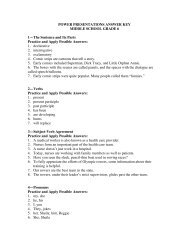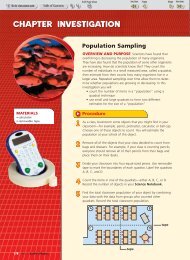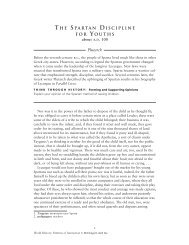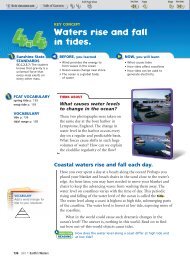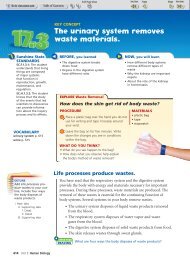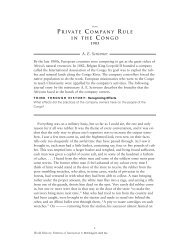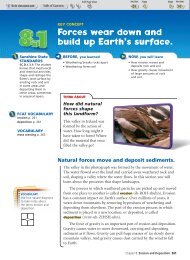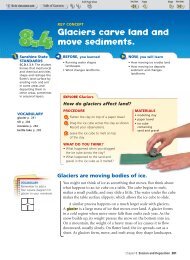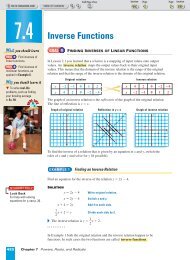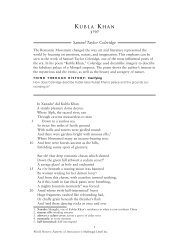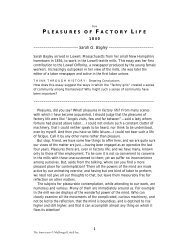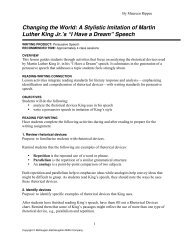Charge needs a continuous path to flow. - ClassZone
Charge needs a continuous path to flow. - ClassZone
Charge needs a continuous path to flow. - ClassZone
Create successful ePaper yourself
Turn your PDF publications into a flip-book with our unique Google optimized e-Paper software.
Sunshine State<br />
STANDARDS<br />
SC.B.1.3.1: The student<br />
identifies forms of<br />
energy and explains<br />
that they can be measured<br />
and compared.<br />
SC.H.1.3.3: The student<br />
knows that science disciplines<br />
differ from<br />
one another in <strong>to</strong>pic,<br />
techniques, and outcomes<br />
but that they<br />
share a common purpose,<br />
philosophy, and<br />
enterprise.<br />
FCAT VOCABULARY<br />
circuit p. 375<br />
VOCABULARY<br />
resis<strong>to</strong>r p. 376<br />
short circuit p. 378<br />
VOCABULARY<br />
Use a frame game diagram<br />
<strong>to</strong> record the term<br />
circuit in your notebook.<br />
KEY CONCEPT<br />
<strong>Charge</strong> <strong>needs</strong> a<br />
<strong>continuous</strong> <strong>path</strong> <strong>to</strong> <strong>flow</strong>.<br />
BEFORE, you learned<br />
• Current is the <strong>flow</strong> of charge<br />
•Voltage is a measure of electric<br />
potential<br />
• Materials affect the movement<br />
of charge<br />
EXPLORE Circuits<br />
How can you light the bulb?<br />
PROCEDURE<br />
1<br />
2<br />
3<br />
Tape one end of a strip of foil <strong>to</strong> the negative<br />
terminal, or the flat end, of the battery. Tape<br />
the other end of the foil <strong>to</strong> the tip at the base<br />
of the light bulb, as shown.<br />
Tape the second strip of foil <strong>to</strong> the positive terminal,<br />
or the raised end, of the battery.<br />
Find a way <strong>to</strong> make the bulb light.<br />
WHAT DO YOU THINK?<br />
•How did you make the bulb light?<br />
•Can you find other arrangements that<br />
make the bulb light?<br />
Electric charge <strong>flow</strong>s in a loop.<br />
MATERIALS<br />
•2 strips of<br />
aluminum foil<br />
•electrical tape<br />
•D cell (battery)<br />
• light bulb<br />
In the last chapter, you read that current is electric charge that <strong>flow</strong>s<br />
from one place <strong>to</strong> another. <strong>Charge</strong> does not <strong>flow</strong> <strong>continuous</strong>ly<br />
through a material unless the material forms a closed <strong>path</strong>, or loop.<br />
A circuit is a closed <strong>path</strong> through which a <strong>continuous</strong> charge can <strong>flow</strong>.<br />
The <strong>path</strong> is provided by a low-resistance material, or conduc<strong>to</strong>r, usually<br />
wire.Circuits are designed <strong>to</strong> do specific jobs, such as light a bulb.<br />
Circuits can be found all around you and serve many different<br />
purposes. In this chapter, you will read about simple circuits, such as<br />
the ones in flashlights, and more complex circuits, such as the ones<br />
that run <strong>to</strong>ys, cameras, computers, and more.<br />
check your reading How are circuits related <strong>to</strong> current?<br />
NOW, you will learn<br />
• About the parts of a circuit<br />
• How a circuit functions<br />
• How safety devices s<strong>to</strong>p current<br />
Chapter 11: Circuits and Electronics 375
eminder<br />
Remember, a battery consists<br />
of two or more cells.<br />
Circuit Parts<br />
1<br />
The voltage<br />
source supplies<br />
electrical<br />
energy <strong>to</strong> the<br />
circuit.<br />
376 Unit 3: Electricity and Magnetism<br />
The Parts of a Circuit<br />
The illustration below shows a simple circuit. Circuits typically<br />
contain the following parts. Some circuits contain many of each part.<br />
1<br />
2<br />
3<br />
4<br />
Voltage Source The voltage source in a circuit provides the electric<br />
potential for charge <strong>to</strong> <strong>flow</strong> through the circuit. Batteries are<br />
often the voltage sources in a circuit. A power plant may also be a<br />
voltage source. When you plug an appliance in<strong>to</strong> an outlet, a circuit<br />
is formed that goes all the way <strong>to</strong> a power plant and back.<br />
Conduc<strong>to</strong>r A circuit must be a closed <strong>path</strong> in order for charge<br />
<strong>to</strong> <strong>flow</strong>. That means that there must be a conduc<strong>to</strong>r, such as wire,<br />
that forms a connection from the voltage source <strong>to</strong> the electrical<br />
device and back.<br />
Switch A switch is a part of a circuit designed <strong>to</strong> break the closed<br />
<strong>path</strong> of charge. When a switch is open, it produces a gap in the<br />
circuit so that the charge cannot <strong>flow</strong>.<br />
Electrical Device An electrical device is any part of the circuit that<br />
changes electrical energy in<strong>to</strong> another form of energy. A resis<strong>to</strong>r is<br />
an electrical device that slows the <strong>flow</strong> of charge in a circuit. When<br />
the charge is slowed, some energy is converted <strong>to</strong> light or heat.<br />
A light bulb is an example of a resis<strong>to</strong>r.<br />
The parts of a basic circuit include a voltage source, conduc<strong>to</strong>r, switch, and<br />
one or more electrical devices.<br />
2<br />
The conduc<strong>to</strong>r<br />
provides a <strong>path</strong><br />
through which<br />
charge can <strong>flow</strong>.<br />
The resis<strong>to</strong>r is<br />
an electrical<br />
device that<br />
converts electrical<br />
energy in<strong>to</strong><br />
another form<br />
of energy.<br />
Would the light bulb be lit if there were no switch in this circuit?<br />
Why or why not?<br />
3<br />
A switch is used<br />
<strong>to</strong> open and close<br />
the circuit.<br />
4
Open and Closed Circuits<br />
Current in a circuit is similar <strong>to</strong> water running through a hose. The <strong>flow</strong><br />
of charge differs from the <strong>flow</strong> of water in an important way, however.<br />
The water does not require a closed <strong>path</strong> <strong>to</strong> <strong>flow</strong>. If you cut the hose, the<br />
water continues <strong>to</strong> <strong>flow</strong>. If you cut a wire, the charge s<strong>to</strong>ps <strong>flow</strong>ing.<br />
Batteries have connections at both ends so that charge can follow<br />
a closed <strong>path</strong> <strong>to</strong> and from the battery. The cords that you see on<br />
appliances might look like single cords but actually contain at least<br />
two wires. The wires connect the device <strong>to</strong> a power plant and back <strong>to</strong><br />
make a closed <strong>path</strong>.<br />
Switches work by opening and closing the circuit. A switch that is<br />
on closes the circuit and allows charge <strong>to</strong> <strong>flow</strong> through the electrical<br />
devices. A switch that is off opens the circuit and s<strong>to</strong>ps the current.<br />
check your reading How are switches used <strong>to</strong> control the <strong>flow</strong> of charge through<br />
a circuit?<br />
Standard symbols are used <strong>to</strong> represent the parts of a circuit. Some<br />
common symbols are shown in the circuit diagrams below. The diagrams<br />
represent the circuit shown on page 376 with the switch in both<br />
open and closed positions. Electricians and architects use diagrams<br />
such as these <strong>to</strong> plan the wiring of a building.<br />
Circuit Diagrams<br />
reminder<br />
Current requires a<br />
closed loop.<br />
Symbols are used <strong>to</strong> represent the parts of a circuit. The circuit diagrams<br />
below show the circuit from page 376 in both an open and closed position.<br />
Key<br />
cell<br />
2-cell<br />
battery<br />
4-cell<br />
battery<br />
open<br />
switch<br />
light bulb<br />
open switch = off<br />
Would charge <strong>flow</strong> through the circuit diagrammed on the left?<br />
Why or why not?<br />
closed switch = on<br />
Chapter 11: Circuits and Electronics 377
OUTLINE<br />
Add this heading <strong>to</strong><br />
your outline, along with<br />
supporting ideas.<br />
I. Main idea<br />
A. Supporting idea<br />
1. Detail<br />
2. Detail<br />
B. Supporting idea<br />
RESOURCE CENTER<br />
CLASSZONE.COM<br />
Explore resources on<br />
electrical safety.<br />
378 Unit 3: Electricity and Magnetism<br />
Current follows the <strong>path</strong> of least resistance.<br />
Since current can follow only a closed <strong>path</strong>, why are damaged cords so<br />
dangerous? And why are people warned <strong>to</strong> stay away from fallen power<br />
lines? Although current follows a closed <strong>path</strong>, the <strong>path</strong> does not have<br />
<strong>to</strong> be made of wire. A person can become a part of the circuit, <strong>to</strong>o.<br />
<strong>Charge</strong> <strong>flow</strong>ing through a person is dangerous and sometimes deadly.<br />
Current follows the <strong>path</strong> of least resistance. Materials with low<br />
resistance, such as certain metals, are good conduc<strong>to</strong>rs. <strong>Charge</strong> will<br />
<strong>flow</strong> through a copper wire but not the plastic coating that covers it<br />
because copper is a good conduc<strong>to</strong>r and plastic is not. Water is also a<br />
good conduc<strong>to</strong>r when mixed with salt from a person’s skin. That is<br />
why it is dangerous <strong>to</strong> use electrical devices near water.<br />
Short Circuits<br />
A short circuit is an unintended <strong>path</strong> connecting one part of a circuit<br />
with another. The current in a short circuit follows a closed <strong>path</strong>, but<br />
the <strong>path</strong> is not the one it was intended <strong>to</strong> follow. The illustration<br />
below shows a functioning circuit and a short circuit.<br />
1<br />
2<br />
Functioning Circuit The charge <strong>flow</strong>s through one wire, through<br />
the light bulb, and then back through the second wire <strong>to</strong> the outlet.<br />
Short Circuit The cord has been damaged and the two wires inside<br />
have formed a connection. Now the <strong>path</strong> of least resistance is<br />
through one wire and back through the second wire.<br />
coating<br />
wires<br />
1 2<br />
In the second case, without the resistance from the lamp, there is<br />
more current in the wires. Too much current can overheat the wires and<br />
start a fire. When a power line falls, charge <strong>flow</strong>s along the wire and<br />
in<strong>to</strong> the ground. If someone <strong>to</strong>uches that power line, the person’s<br />
body becomes part of the <strong>path</strong> of charge. That much charge <strong>flow</strong>ing<br />
through a human body is almost always deadly.<br />
check your reading Why are short circuits dangerous?
Grounding a Circuit<br />
Recall that when lightning strikes a lightning rod, charge <strong>flow</strong>s in<strong>to</strong><br />
the ground through a highly conductive metal rod rather than<br />
through a person or a building. In other words, the current follows<br />
the <strong>path</strong> of least resistance. The third prong on some electrical plugs<br />
performs a similar function. A circuit that connects stray current safely<br />
<strong>to</strong> the ground is known as a grounded circuit. Because the third prong<br />
grounds the circuit, it is sometimes called the ground.<br />
In this illustration, green<br />
represents the <strong>path</strong> that<br />
connects the appliance and<br />
the outlet <strong>to</strong> the ground.<br />
ground<br />
wire<br />
Normally, charge <strong>flow</strong>s through one prong, along a wire <strong>to</strong> an<br />
appliance, then back along a second wire <strong>to</strong> the second prong. If there<br />
is a short circuit, the charge might <strong>flow</strong> dangerously <strong>to</strong> the outside of<br />
the shell of the appliance. If there is a ground wire, the current will<br />
<strong>flow</strong> along the third wire and safely in<strong>to</strong> the ground, along either a<br />
buried rod or a cold water pipe.<br />
check your reading What is the purpose of a ground wire?<br />
Safety devices control current.<br />
Orange is used in this illustration<br />
<strong>to</strong> represent the <strong>path</strong> that connects<br />
the appliance’s circuit <strong>to</strong> a power<br />
source and back.<br />
connects <strong>to</strong><br />
ground wire<br />
Suppose your living room wiring consists of a circuit that supplies<br />
current <strong>to</strong> a television and several lights. One hot evening, you turn<br />
on an air conditioner in the living room window. The wires that<br />
supply current <strong>to</strong> the room are suddenly carrying more current than<br />
before. The lights in the room become dim. Too much current in a<br />
circuit is dangerous. How do you know if there is <strong>to</strong>o much current<br />
in a wire?<br />
Fortunately, people have been using electric current for over a<br />
hundred years. An understanding of how charge <strong>flow</strong>s has led <strong>to</strong> the<br />
development of safety devices. These safety devices are built in<strong>to</strong><br />
circuits <strong>to</strong> prevent dangerous situations from occurring.<br />
! SAFETY TIPS<br />
• Never go near a<br />
fallen power line.<br />
•Never <strong>to</strong>uch an<br />
electrical appliance<br />
when you<br />
are in the shower<br />
or bathtub.<br />
•Always dry your<br />
hands thoroughly<br />
before using<br />
an electrical<br />
appliance.<br />
• Never use an<br />
electrical cord<br />
that is damaged<br />
in any way.<br />
•Never bend or<br />
cut a ground<br />
prong in order <strong>to</strong><br />
make a grounded<br />
plug fit in<strong>to</strong><br />
an ungrounded<br />
outlet.<br />
Chapter 11: Circuits and Electronics 379
How Fuses Work<br />
How can you s<strong>to</strong>p a current?<br />
PROCEDURE<br />
1<br />
2<br />
3<br />
4<br />
new<br />
fuse<br />
blown<br />
fuse<br />
If you turn on an air conditioner in a room full of other electrical<br />
appliances that are already on, the circuit could overheat. But if the<br />
circuit contains a fuse, the fuse will au<strong>to</strong>matically shut off the current.<br />
A fuse is a safety device that opens a circuit when there is <strong>to</strong>o much<br />
current in it. Fuses are typically found in older homes and buildings.<br />
They are also found in cars and electrical appliances like air<br />
conditioners.<br />
A fuse consists of a thin strip of metal that is inserted in<strong>to</strong> the circuit.<br />
The charge in the closed circuit <strong>flow</strong>s through the fuse. If <strong>to</strong>o much<br />
charge <strong>flow</strong>s through the fuse, the metal strip melts. When the strip<br />
has melted and the circuit is open, the fuse is blown. The pho<strong>to</strong>graphs<br />
on the left show a new fuse and a blown fuse. As you can see, charge<br />
cannot <strong>flow</strong> across the melted strip. It has broken the circuit and<br />
s<strong>to</strong>pped the current.<br />
How much current is <strong>to</strong>o much? That varies. The electrician who<br />
installs a circuit knows how much current the wiring can handle. He<br />
or she uses that knowledge <strong>to</strong> choose the right kind of fuse. Fuses are<br />
measured in amperes, or amps. Remember that amperage is a measure<br />
of current. If a fuse has blown, it must be replaced with a fuse of the<br />
same amperage. But a fuse should be replaced only after the problem<br />
that caused it <strong>to</strong> blow has been fixed.<br />
Fuses<br />
Use the alliga<strong>to</strong>r clips <strong>to</strong> clip one end of each wire <strong>to</strong> the steel wool strand.<br />
Place the steel wool strand in the jar. Tape the wires <strong>to</strong> the sides of the jar.<br />
Clip the free end of one wire <strong>to</strong> the negative terminal of the battery.<br />
What do you predict will happen when you complete the circuit?<br />
Clip the free end of the remaining wire <strong>to</strong> the positive terminal<br />
of the battery and observe the steel wool strand.<br />
WHAT DO YOU THINK?<br />
•What did you observe when you completed<br />
the circuit? Why did that happen?<br />
• How can you s<strong>to</strong>p the current?<br />
CHALLENGE How is the setup in this<br />
activity similar <strong>to</strong> a fuse that would be<br />
found in a home circuit? How does it differ?<br />
380 Unit 3: Electricity and Magnetism<br />
SKILL FOCUS<br />
Making Models<br />
MATERIALS<br />
•2 pieces of insulated<br />
wire with<br />
alliga<strong>to</strong>r clips<br />
• single strand of<br />
steel wool<br />
•glass jar<br />
• tape<br />
•6 V battery<br />
TIME<br />
15 minutes
Other Safety Devices<br />
Most modern homes do not use fuses. Instead, they use safety<br />
devices called circuit breakers. Circuit breakers, unlike fuses,<br />
do not have <strong>to</strong> be replaced every time they open the circuit.<br />
Like fuses, circuit breakers au<strong>to</strong>matically open the circuit when <strong>to</strong>o<br />
much charge <strong>flow</strong>s through it. If the circuit becomes overloaded<br />
or there is a short circuit, the wire and the breaker grow hot.<br />
That makes a piece of metal inside the breaker expand. As it<br />
expands, it presses against a switch. The switch is then flipped <strong>to</strong><br />
the off position and the current is s<strong>to</strong>pped. Once the problem is<br />
solved, power can be res<strong>to</strong>red manually by simply flipping the<br />
switch back. The illustration on the right shows a circuit breaker.<br />
check your reading How are circuit breakers similar <strong>to</strong> fuses?<br />
The pho<strong>to</strong>graph at the bot<strong>to</strong>m right shows another<br />
safety device—a ground-fault circuit interrupter<br />
(GFCI) outlet. Sometimes a little current leaks out of an<br />
outlet or an appliance. Often it is so small you do not<br />
notice it. But if you happen <strong>to</strong> have wet hands, <strong>to</strong>uching<br />
even a small current can be very dangerous.<br />
GFCI outlets are required in places where exposure<br />
<strong>to</strong> water is common, such as in kitchens and bathrooms.<br />
A tiny circuit inside the GFCI outlet moni<strong>to</strong>rs the current<br />
going out and coming in. If some of the current<br />
starts <strong>to</strong> <strong>flow</strong> through an unintended <strong>path</strong>, there will be<br />
less current coming in <strong>to</strong> the GFCI. If that happens, a<br />
circuit breaker inside the GFCI outlet opens the circuit<br />
and s<strong>to</strong>ps the current. To close the circuit again, you<br />
push “Reset.”<br />
KEY CONCEPTS<br />
1. Describe three parts of a<br />
circuit and explain what<br />
each part does.<br />
2. Explain the function of a<br />
ground wire.<br />
3. What do fuses and circuit<br />
breakers have in common?<br />
CRITICAL THINKING<br />
4. Apply Suppose you have built<br />
a circuit for a class project. You<br />
are using a flat piece of wood<br />
for its base. How could you<br />
make a switch out of a paperclip<br />
and two nails?<br />
5. Communicate Draw a<br />
diagram of a short circuit.<br />
Use the symbols for the parts<br />
of a circuit.<br />
circuit breaker<br />
open<br />
circuit<br />
ground-<br />
fault<br />
circuit<br />
interrupter<br />
CHALLENGE<br />
6. Evaluate A fuse in a home<br />
has blown and the owner<br />
wants <strong>to</strong> replace it with a fuse<br />
that can carry more current.<br />
Why might the owner’s decision<br />
lead <strong>to</strong> a dangerous<br />
situation?<br />
Chapter 11: Circuits and Electronics 381



